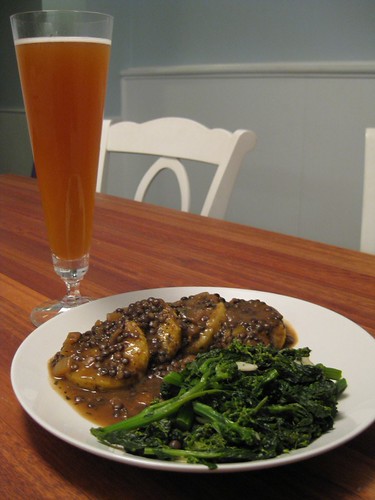Way back in the early days of my vegan life, I picked up a copy of a “vegan cooking zine” called Please Don’t Feed the Bears. I don’t recall where I got the first copy, but it was one of very few cookbooks I had at the time and I used it constantly. With it, I basically learned to cook. I’ll never forget the time I tried to make falafel from it, not knowing a “clove” of garlic is different than a bulb of garlic. What a mess. Anyway, soon after getting the first issue I was at a conference at Penn State and ran into the author, Brad Misanthropic, who was selling the second issue of the zine. I told him how great I thought the first issue was, so he gave me a copy of the second. More than a decade later, I still go back to that zine – usually for one recipe, Hoppin’ John.
I’ve made a few minor modifications to the recipe, mainly subbing “tofu or seitan” with a vegan chorizo called “Soyrizo.”

I can usually find the soyrizo in the produce section of the local supermarket. For the beer, I used Sierra Nevada Pale Ale. I wanted to make this recipe simple and SN pale is a great beer that nearly everyone has access to. One other change I made for this recipe was inspired by the Hoppin’ John recipe on the can of black-eyed peas I used. The recipe suggested adding mustard greens as a garnish, so I added a bunch for the last 5 minutes of cooking. Here is the recipe, using canned beans instead of dried for simplicity:
2 15.5 oz cans black-eyed peas, drained
1 c uncooked white rice
1 onion, chopped
1 green pepper, chopped (I never add this, but its in the originial recipe)
1 package Soyrizo
2 Tbsp canola or vegetable oil
1/2 tsp onion powder
1/2 tsp cayenne pepper
1/4 tsp black pepper
1 tsp salt
2 c water
1 c beer of your choice
1 bunch of mustard greens, chopped
In a large sauce pan, saute the onions and green pepper (if using) in oil for 5 minutes. Add Soyrizo and saute for another 5 minutes or until onions are almost clear. Add rice and stir to coat. Add drained black-eyed peas, spices, water and beer. Bring to a boil and cook for 1 minute. Stir, then reduce heat to low. Cover and simmer for 20 minutes. Add mustard greens and cook for another 5 minutes. Remove from the stove and let sit for 10 minutes. Keep in mind, this makes a lot.

I’ve made this recipe many times, but this is the first with SN pale and mustard greens. I think it added a nice bittersweet flavor and I would definitely use them again. The greens also gave it more texture, so it’s not just a pile of mushy starch and protein. The slight southern spice from the food was perfect for the citrusy hop flavors in the pale ale. If you want to spice it up more (and I suggest you do), throw in some of your favorite hot sauce and/or some Dinosaur Cajun Foreplay.
I’ve also made this in the slow cooker, which made it even easier. Just be sure NOT to add the onions to the slow cooker. For some reason, they just don’t do well in there and create a horrible flavor that will be overwhelming. Saute the onion in a frying pan for a few minutes, then toss it in at the end. When I made it in the slow cooker, I used an Aventinus clone I brewed for the beer. It came out hearty and more stick-to-your-ribs, stew-like, with a peppery flavor. I brought it to a barley wine and imperial stout tasting in the winter, so it went nicely.
Overall, simple, relatively cheap and very tasty. Enjoy.










